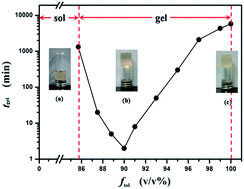Solvent-mediated gel formation, hierarchical structures, and rheological properties of organogels†
Abstract
We report the formation of solvent-mediated gels as well as their hierarchical structures and rheological properties. The gelator used is a hybrid with a molecular structure of cholesterol–polyoxometalate–cholesterol, in which the cholesterol dissolves well in toluene and N,N-dimethylformamide (DMF), whereas the polyoxometalate cluster dissolves only in DMF. These solubility differences enable the gelator to form thermally reversible supramolecular organogels by mixing solvents of toluene and DMF when the volume fraction, ftol, of toluene is larger than 85.7 v/v%. We found a V-shaped correlation between the gelation times, tgel and ftol: tgel decreases from 1300 min to 2 min when ftol increases from 85.7 v/v% to 90.0 v/v%. It then increases from 2 min to 5800 min when ftol further increases from 90.0 v/v% to 100.0 v/v%. We observed ribbon-like self-assembled structures in the gels as well as a structural evolution from rigid and straight ribbons to twistable ones from ftol = 85.7 v/v% to ftol = 100.0 v/v%. These ribbons constitute two three-dimensional (3D) gel networks: one is constructed via physical connection of the rigid and straight ribbon, and the other is built up from ribbons splitting and intertwining. The latter has a better 3D gel network that offers improved rheological properties. Fundamentally, this solvent-mediated approach regulates the balance between solubility and insolubility of this gelator in the mixing solvents. It also provides a new method for the preparation of organogels.


 Please wait while we load your content...
Please wait while we load your content...